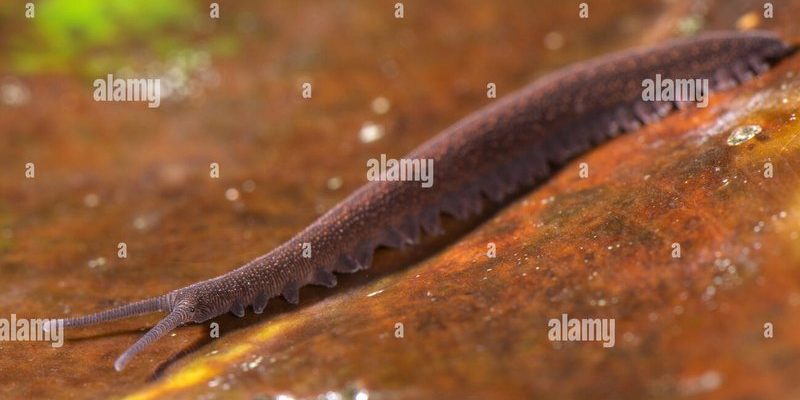
Velvet worms, or *Onychophora*, are often overshadowed by flashier species like butterflies or hummingbirds. But here’s the thing: these little guys are crucial for maintaining the health of their environment. Think of them as the unsung heroes in a bustling community, quietly working behind the scenes. They thrive in moist, leafy habitats where they hunt for small invertebrates and interact with fungi and bacteria, creating a balanced ecosystem. Let me explain how these creatures fit into the larger picture of leaf litter ecosystems.
What Are Velvet Worms?
Velvet worms are soft-bodied, segmented animals that are commonly found in tropical and subtropical environments. They can be easily recognized by their velvety texture and distinct body structure, which includes numerous legs that resemble tiny, fleshy appendages. Unlike most insects, they don’t have a hard exoskeleton, which makes them particularly vulnerable but also incredibly adaptable.
These organisms are nocturnal, often hiding during the day under piles of leaves or logs. At night, they venture out to hunt, using a unique method that involves shooting a sticky substance to trap their prey. This hunting style is not just effective; it also underscores their role as *predators* in the ecosystem. Imagine watching a tiny superhero launch a web of silk to catch its dinner—that’s pretty much what velvet worms do!
The Role of Velvet Worms in Leaf Litter Ecosystems
Velvet worms contribute significantly to the leaf litter ecosystem in several ways. First, they help in **nutrient recycling**. As they consume organic matter and other small invertebrates, they break down these materials into simpler forms. This process enriches the soil with nutrients, which can then be utilized by plants.
Additionally, by preying on other organisms, velvet worms help control populations of pests. They act as a natural pest control method, keeping in check the numbers of smaller invertebrates that could otherwise become too dominant. This balance is essential for the health of the forest floor, ensuring that various species can coexist without overwhelming one another.
Lastly, their existence supports a wider food web. Velvet worms themselves are prey for larger animals and contribute to the diet of various predators, further integrating them into their ecosystems. Without them, the intricate balance of life within leaf litter would be disrupted.
How Velvet Worms Adapt to Their Environment
Adapting to their surroundings is key to the survival of velvet worms. Their **moisture-sensitive skin** requires them to stay in humid environments, which is why they thrive in leaf litter. This habitat not only offers shelter but also helps maintain the moisture they need to prevent drying out.
Moreover, their hunting technique illustrates their adaptation. They can produce a slime-like substance that allows them to snare prey. This not only showcases their evolutionary uniqueness but also highlights their role as efficient hunters. Imagine a tiny, sticky superhero sneaking up on its prey in the shadows of the forest floor!
Additionally, velvet worms have a fascinating reproductive strategy. They can reproduce both sexually and asexually, which allows for genetic diversity and ensures survival in changing environments. This flexibility is vital, especially since many species face habitat loss and climate shifts.
Interactions With Other Organisms
In the leaf litter ecosystem, velvet worms interact with a variety of organisms, creating a dynamic food web. They share their habitat with decomposers such as fungi and bacteria, which break down dead organic matter. This process is crucial for nutrient cycling, as it enriches the soil and supports plant life.
Additionally, velvet worms are prey for several larger species, including birds and small mammals. This predator-prey relationship is important for maintaining balance. When velvet worm populations are healthy, they help sustain the populations of their predators.
However, it’s not just about food. Velvet worms also participate in **microbial activity** in the soil. As they move through the leaf litter, they aerate the soil, allowing for better water infiltration and root penetration. Their movements contribute to a healthier soil structure, which benefits plant growth.
Threats to Velvet Worms and Their Ecosystems
Unfortunately, velvet worms face several threats due to human activities. Habitat destruction, mainly from logging and urban development, can severely impact their populations. As their leaf litter homes are removed, they lose not only their habitat but also their food sources.
Climate change also plays a significant role. Changes in temperature and moisture levels can disrupt their delicate balance. Since velvet worms thrive in specific humidity levels, any alteration can directly affect their survival rates.
Conservation efforts are crucial to protect these unique creatures. By preserving their habitats and encouraging biodiversity, we can help ensure that velvet worms continue to play their vital role in leaf litter ecosystems.
The Wonder of Velvet Worms
Exploring the world of velvet worms may feel like diving into a hidden treasure trove of nature. They’re not just quirky creatures; they’re essential components of a balanced ecosystem. Their unique adaptations and fascinating habits show how life can thrive in even the smallest crevices of our environment.
When you think about leaf litter and the life it harbors, remember the velvet worm. These creatures may not be the most glamorous, but their influence on their ecosystem is profound. The next time you’re out in nature, take a moment to appreciate the unseen heroes like velvet worms working tirelessly beneath the leaves.
In closing, velvet worms are a perfect example of how every organism, no matter how small, contributes to the overall health of an ecosystem. By understanding their role and protecting their habitats, we can help maintain the intricate dance of life that exists beneath our feet. So, let’s celebrate these fascinating little creatures and the amazing ecosystems they support!

